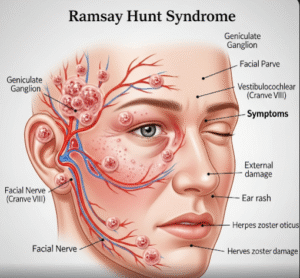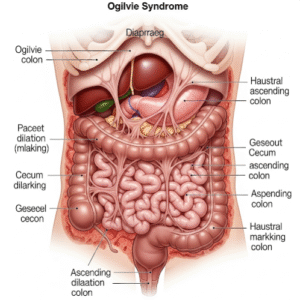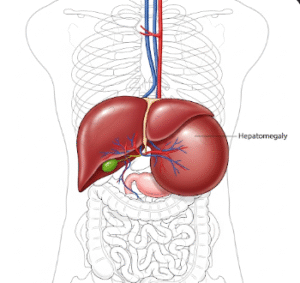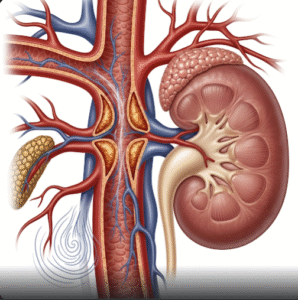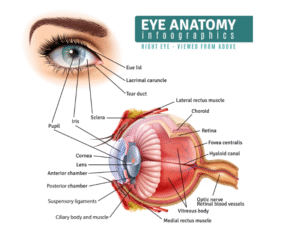Overview
Ocular migraine, also known as retinal migraine, is a condition that causes temporary visual disturbances or vision loss in one eye, often followed by or accompanied with a migraine headache. The visual symptoms are usually brief and reversible, but the condition can be alarming and disruptive.
It is important to differentiate ocular migraine from migraine with aura, which affects both eyes and originates in the brain. Ocular migraines specifically involve reduced blood flow or nerve activity in the retina of one eye.
What is Ocular Migraine?
Ocular migraine is a rare type of migraine that affects the retina, the light-sensitive tissue at the back of the eye. During an episode, a person may experience temporary partial or complete blindness in one eye, lasting anywhere from a few minutes to an hour. These visual episodes are typically painless, but some people may develop a headache either during or shortly after.
The exact mechanism is not fully understood, but it’s believed to involve spasms or constriction of blood vessels that supply the retina, leading to temporary ischemia (lack of oxygen).
Symptoms
Symptoms of an ocular migraine usually affect only one eye and include:
- Temporary vision loss in one eye (partial or complete)
- Scintillations: flashing lights or zigzag patterns
- Blurred or dimmed vision
- Blind spots (scotomas)
- Pulsing or flickering light
- Gradual spreading of visual disturbance
- Headache, usually following the visual episode (not always present)
The visual symptoms typically last 10–60 minutes and fully resolve without permanent damage. If both eyes are affected, the condition is more likely a migraine with aura, not ocular migraine.
Causes
Ocular migraines are thought to result from temporary reductions in blood flow to the retina. Common triggers include:
- Stress and fatigue
- Hormonal changes (e.g., menstruation, pregnancy)
- Bright or flickering lights
- High altitude or low oxygen environments
- Skipping meals or dehydration
- Certain foods (aged cheese, chocolate, red wine)
- Caffeine or alcohol
- Medications such as oral contraceptives
- Strong scents or smoke
Some individuals have a genetic predisposition to migraines, and ocular migraines may be part of their broader migraine pattern.
Risk Factors
You may be more likely to experience ocular migraines if you:
- Have a personal or family history of migraines
- Are a woman of childbearing age
- Use oral contraceptives or hormone therapy
- Are exposed to frequent migraine triggers
- Have underlying vascular or neurological conditions
- Experience frequent stress or poor sleep
Though rare, ocular migraines are more common in people who also suffer from migraine with aura or chronic migraines.
Complications
Ocular migraines are typically benign and do not cause permanent vision loss. However, possible complications include:
- Recurrent visual disturbances affecting daily activities
- Misdiagnosis as retinal detachment or stroke
- Anxiety or fear due to vision loss episodes
- Risk of retinal damage if symptoms are due to another cause (e.g., retinal artery occlusion)
- Impact on driving or work performance
It is important to consult a doctor to confirm the diagnosis and rule out other serious eye or neurological conditions.
Prevention
Prevention focuses on avoiding known triggers and maintaining overall health:
- Identify and avoid triggers (foods, lights, stress, etc.)
- Keep a migraine diary to track patterns
- Maintain regular sleep and eating schedules
- Manage stress through relaxation techniques or therapy
- Stay hydrated and limit caffeine or alcohol
- Review medications with your doctor
- Use protective eyewear or sunglasses in bright environments
- Limit screen exposure or take frequent breaks
For people with frequent episodes, preventive medications may be recommended.
Treatment Options in Korea
South Korea offers comprehensive care for ocular migraines through neurology and ophthalmology collaboration, ensuring accurate diagnosis and targeted treatment.
1. Diagnosis
- Detailed symptom history and pattern tracking
- Ophthalmologic examination to rule out retinal disorders
- Dilated eye exam
- Visual field testing
- Imaging (OCT, fluorescein angiography) to assess retinal blood flow
- Brain imaging (MRI or CT scan) if neurological symptoms are suspected
2. Acute Management
- Most ocular migraines resolve on their own without treatment
- During an episode:
- Rest in a dark, quiet room
- Close the affected eye
- Use a cold compress or lie down
- Over-the-counter pain relievers (acetaminophen, NSAIDs) if headache follows
3. Preventive Treatment (if frequent episodes)
- Beta-blockers (e.g., propranolol)
- Calcium channel blockers
- Anticonvulsants (e.g., topiramate)
- Tricyclic antidepressants
- Botox injections (for chronic migraine)
- Lifestyle modification and trigger management
4. Top Hospitals in Korea for Migraine and Eye Health
- Seoul National University Hospital – Neuro-Ophthalmology Clinic
- Samsung Medical Center – Headache and Vision Center
- Asan Medical Center – Neurology and Retina Units
- Severance Hospital (Yonsei University) – Migraine and Retina Specialty
- Kim’s Eye Hospital – Retinal and Neuro-Ophthalmology Department
These facilities offer:
- Specialist-level care for rare migraines
- Comprehensive diagnostics for eye and brain function
- Multilingual services for international patients
- Access to advanced treatments and monitoring







